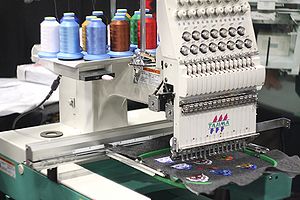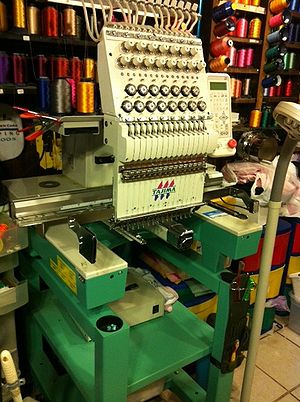Tajima TEJT C1501
{{#invoke:Infobox|infobox}}
The ultra-compact TEJT-C1501 NEO was introduced by Tajima in 2002. The single head, 15-needle Tajima NEO is the only table-top, compact embroidery machine ever made by Tajima. The original NEO was designed to take to retail kiosks, sporting venues, trade shows, and other events. It was a single-head machine. The Neo came with a 270 degree cap system and also came with a floppy disk drive.
The Neo is an entry-level embroidery machine in the Tajima lineup of embroidery machines. In Tajima marketing materials, NEO stood for "Never Ending Opportunities" which was meant to emphasize the machine's ability to work with a wide variety of garments.
Tajima NEO
History
Around 2002 Tajima bought the Toyota Embroidery Machine rights.
The Tajima NEO borrowed a lot of the looks and electronics from Toyota. Tajima has since discontinued the Toyota line. The machine that replaced the Toyota line is called Expert and is also very identical to the NEO as both are produced by the same company with very small changes. The Tajima NEO is sometimes refereed to as a clone of the Toyota ESP 9000 (or vice-versa). The Tajima NEO 2 is very similar feature-wise to the Toyota ESP 9100.
NEO Specifications
| Model | Heads | Needles | EMB Space / Head | Max SPM | Pwr Cons. | Years |
|---|---|---|---|---|---|---|
| TEJT-C | 1 | 15 | 19.4 IN x 14 IN | 1200 | 225W | 2002 - 2008 |
| TEJTII-C | 1 | 15 | 19.4 IN x 14 IN | 1200 | 225W | 2007 - Present |
| TEMX-C | 1 | 15 | 19.4 IN x 14 IN | 1200 | 225W | 2008 - Present |
Tajima TEJT Upgrades

The Tajima TEJT (the original NEO) shipped with a floppy disk drive. For reliability or performance improvement, the legacy drive in many of these older machines has since been upgraded to a modern USB drive such as the FloppyToUSB which allows the operator to use a solid state USB stick to load embroidery design files from their computer instead of inserting a magnetic floppy diskette.
Tajima Legend
Tajima used several codes in their models that described basic features of the machines. The letters in the model number usually
- TME
- Machines with TME in their model without any other letters (numbers only) is a very late 1970s - 1990 flat only machine.
- TME-C
- Predecessor to the TME, a Tajima machine with a C in it represents Cylinder (tubular) embroidery. Therefore machines with the letter C in their model, have removable tables.
- TME-HC, TMEF-H, H
- Models with H in their model have the H model control panels. A TME-HC is an Arm Type machine with removable tables and the H model control panel. A TMEF-H machine is a flat machine with the H model control panel.
- TMEF
- Machines with the F code are Bridge Machine (not arm type). If there are not more letter codes then this machine is a flat only machine (does not to tubular or caps).
- TMM
- TMM machines were collaboration Melco and Tajima machines. These machines have a Melco control panel/keyboard.
Tajima Years, Date or Age
The year of the Tajima machine can usually be found on a sticker behind the machines control panel or power boxes. These years are usually the year that the machines electronics were Quality Control checked at the Japan factory. The months listed on these stickers will probably be different. It usually took about 3 months from production to delivery to the original customers location. Later models had the production year stamped on the data plate.
If the machine is old and does not have a sticker, then the machine is probably older than 1990.
Buying
Tajima embroidery machines are probably one of the best machines on the market. They are more expensive that most all competing models but, they are very solidly built and have a good resell market. There are a lot of embroidery machine technicians available world wide and parts are pretty easy to find even for older models.
Selling
TheEmbroideryWarehouse buys and sells most every make and model of Tajima embroidery machines located within the continental USA. They also purchase parts, parts machines, salvage machines and most everything else related to embroidery equipment.
